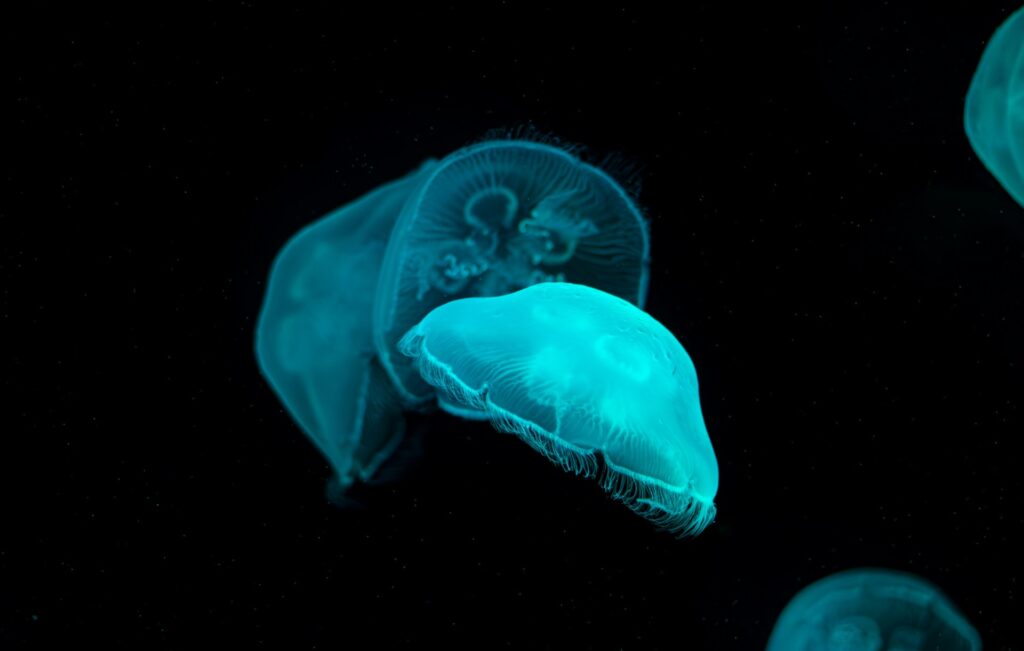When one thinks of aliens, the mind often drifts to Hollywood’s famous characters, and Yoda from Star Wars is what my mind conjures up. In the next moment one may disregard aliens altogether and try to dismiss the idea as one, that should be left alone for the movies. But what if the extra-terrestrials have been here all along, living with us, lurking not in the stars and galaxies, but in the dark trenches of Earth’s oceans? Earth’s deep-sea creatures look different, more so because for the common man, they remain unexplored and unknown. Evolutionary biologists are discovering these creatures with adaptations for extreme deep marine environment, that we don’t encounter in land species, raising questions about these life forms—and life as we know it. In this article, we dive deep into marine ecosystems to explore 8 features of sea life that could make us question whether these are aliens living amongst us!
1. Chemosynthetic bacteria near hydrothermal vents
Chemosynthetic bacteria grow in shallow crusts near hot submarine vents 2000 to 3000 m below sea level at temperatures of 3500C. Here, such extreme environment induces a cycling of water, upward-moving hot hydrothermal water from vents meets downward moving cold, oxygenated seawater. A transfer of energy takes place with geothermal energy converting to chemical energy in the form of inorganic compounds. Bacteria assimilate these compounds to form organic carbon, thus becoming the first trophic level for many forms of marine life at these deep sea levels. Bacteria such as methanogenic and sulphur-reducing, form symbiotic relationships with invertebrates such as Riftia pachyptila—giant tube worms and give rise to a local ecosystem (Jannasch and Mottl)
These ecosystems raise the possibility of life in the absence of sunlight and photosynthesis, making a valid point that life could exist with chemosynthesis in other planets.
2. Squids with RNA editing
Cephalopod squids have been found to undergo a large-scale post-transcriptional RNA editing, which allows for a diversity in proteins beyond that which is coded in the genome. This reflects in their specialised nervous systems (Liscovitch-Brauer et al.)
This is unlike what is seen in humans, where most proteins are coded by the DNA, transcribed onto the mRNA and translated by the tRNA.
3. The Immortal Jellyfish
The medusa Turritopsis nutricula can transform back to an earlier stage of development, such as polyps—escaping progression, death and achieving immortality (Piraino et al). Immortality is linked to the idea of an alien life. This jellyfish has cracked that code.
4. Bioluminescence in Deep-Sea Fish
Bioluminescence is the emission of visible light by an organism as a result of a natural chemical reaction that involves oxidation of a light-emitting, luciferin, catalysed by the enzyme luciferase or a photoprotein. This feature that exists in bacteria, protists, squids and fish helps these organisms in camouflage, predator-prey interactions, or communication. Few terrestrial species demonstrate bioluminescence such as fireflies, insects and fungi. Most larger vertebrates and flowering plants do not demonstrate this capability. It is possible that the oceans, most parts of which are dimly lit, provide a ground for long uninterrupted evolution (Haddock et al.)
5. Copper-Based Blood Circulation in Octopus
Unlike humans with iron-rich red blood, many sea creatures, such as horseshoe crabs and octopuses, have blue blood due to the copper-based molecule hemocyanin. This reflects a completely different adaptation for oxygen transport, one that would be better suited to low-oxygen, high-pressure environments that could exist in extreme environments.
6. Transparent Bodies in Squids
Species like the glass squid and barreleye fish use transparency to evade predators. The physical basis of transparency is still under research, and is considered a visual adaptation mechanism. Evolution has provided these organisms with an invisible cloak, which is rare in terrestrial species (Johnsen.)
7. Electro-sensing Abilities in Sharks
Cartilaginous fish like sharks and rays possess electroreceptors called ampullae of Lorenzini, which are gel-filled sensory organs capable of detecting weak electric fields produced by prey such as the flatfish. Even if flatfish hide themselves under sand, the sharks and rays are able to detect their prey using electro-sensing. These senses resemble bio-surveillance that is well beyond human capability.
8. Life Without Oxygen
Recent scientific expeditions have shown that deep anoxic hypersaline L’Atalante basin of Mediterranean Sea is inhabited by species of Metazoans, Loricifera, which survive in anoxic environments. They sustain on anaerobic metabolism, supported by lack of mitochondria, and a large number of hydrogenosome-like organelles, associated with endosymbiotic prokaryotes. These organisms push the boundaries of where and in what conditions life can exist on Earth, conditions that are extreme and hostile. They lend a lens to explore the kind of organisms that can live in the absence of oxygen on other planets (Danovaro et al.)
BotThoughts
The deep ocean remains, still largely a world of mysterious creatures. It has extreme marine environments such as hydrothermal vents, high pressure systems, hypersaline and anoxic basins. Even normal marine species may not survive here. Those that do inhabit such extreme environments show signs of anatomical and biochemical adaptations and evolution with respect to such extremes. The deep ocean does makes us look at the depth of some questions such as: could life exist in extremes on other planets.
“Are we alone?”
“Have we really looked beneath the surface?”
References
Danovaro, Roberto, et al. “The First Metazoa Living in Permanently Anoxic Conditions.” BMC Biology, vol. 8, no. 1, Apr. 2010, https://doi.org/10.1186/1741-7007-8-30.
Haddock, Steven H. D., et al. “Bioluminescence in the Sea.” Annual Review of Marine Science, vol. 2, no. 1, Dec. 2009, pp. 443–93. https://doi.org/10.1146/annurev-marine-120308-081028.
Jannasch, Holger W., and Michael J. Mottl. “Geomicrobiology of Deep-Sea Hydrothermal Vents.” Science, vol. 229, no. 4715, Aug. 1985, pp. 717–25. https://doi.org/10.1126/science.229.4715.717.
Johnsen, Sönke. “Hidden in Plain Sight: The Ecology and Physiology of Organismal Transparency.” Biological Bulletin, vol. 201, no. 3, Dec. 2001, pp. 301–18. https://doi.org/10.2307/1543609.
Liscovitch-Brauer, Noa, et al. “Trade-off Between Transcriptome Plasticity and Genome Evolution in Cephalopods.” Cell, vol. 169, no. 2, Apr. 2017, pp. 191-202.e11. https://doi.org/10.1016/j.cell.2017.03.025.
Piraino, S., et al. “Reversing the Life Cycle: Medusae Transforming Into Polyps and Cell Transdifferentiation in Turritopsis Nutricula (Cnidaria, Hydrozoa).” Biological Bulletin, vol. 190, no. 3, June 1996, pp. 302–12. https://doi.org/10.2307/1543022.




